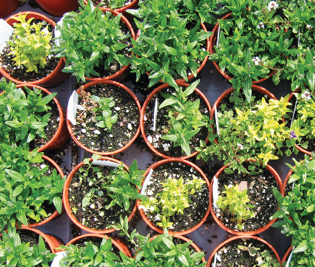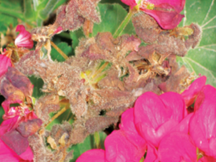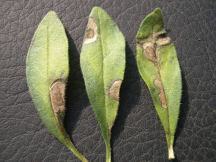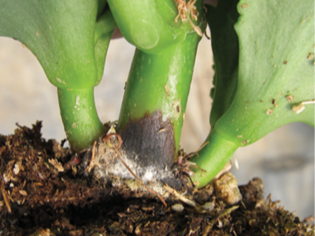
Each year, the diseases affecting greenhouse crops don’t change, but they can evolve. And when it comes to studies and new products, those processes take time and are not guaranteed to yield the necessary results. We spoke with Dr. Ann Chase, president of Chase Horticultural Research, to gain more insight into advancements in disease control and some of the diseases that most concern growers.
Greenhouse Management: Are there any specific topics you’re currently concerned about regarding disease control?
Ann Chase: The biggest thing on my mind, and it has been for maybe a year or so — is the outbreaks of disease that are starting with propagation. That is the biggest concern I’ve gotten year-round — a lot of outbreaks that turned out to be because the problem, the disease, came on the plant material.
GM: What can growers do to prevent the spread of disease during propagation? And are there specific diseases you’ve seen more frequently than others in the propagation stage?
AC: First, they need to know what might go wrong with their plants, what the common problems they might have are and make sure people are trained to recognize early signs of it. They have to do that with insects too, honestly. There are some insects that are being transported on plant material, too.
What I would say is that there are viruses and bacteria that are really becoming problems, [but] not specific ones, because it depends on the plant material itself.

GM: What disease issues are you most interested in, looking into 2017?
AC: It’s interesting to see how many biopesticides — whether they are biological controls or others derived from biological organisms — how many of the standard companies are really pursuing that. It’s not just a few products — there’s more and more all the time. From what I can tell by looking at the data and all the trial work I can find, the stuff is starting to work as well as conventional chemistry, as long as the directions are being followed on how to use it.
GM: Do you think that’s a good thing for growers?
AC: Yes, because the desire to have many different tools is getting higher and higher. There’s a fair amount of ornamental growers — and they have been probably for the last, at least five years, maybe longer — that are getting into edibles, so the desire for organic materials has gotten much, much higher, even if we’re not eating the product. I’d say it is a very positive thing because I don’t see at the same time a lack of conventional chemicals that are extremely good. It’s not like they’re doing one or the other; they’ve really just started to embrace the biopesticides. And growers [do] already, but they’ve got to have a lot of different choices, frankly, because of the number of crops and problems we have in greenhouse production.

GM: Do you think the desire for organics has led to more exploration of options that weren’t considered before?
AC: I do. I really think it’s broadened out the targets of where to look for products.
[In my opnion], we have to go biological, an actual biological, not just a biopesticide, but something that actually is an organism. I think we have to go that way because there are diseases we cannot control with conventional chemistry. And our only real hope is to engage an organism or combination of organisms to create a multitude of chemicals as they’re growing. That’s the only way we are going to solve some of these other problems, by getting much more complex. And the organisms are what’s going to give us that possibility because they basically react to the environment and create chemistry in response to it, or they grow and attack directly. The complexity of the biologicals, which makes them tougher to use, is actually going to be what saves us [in the case of] some of these diseases.
One example of [a disease] that is treated [in a biological] way is crown gall [Agrobacterium tumefaciens]. And it’s the only thing that has [been] proven to work worldwide. Other diseases that come to mind that will need biologicals are Pythium and Fusarium, more than almost anything because they are very hard to control.

GM: One big concern for growers is Tomato spotted wilt virus (TSWV)? How can they control it?
AC: It’s got a very large host range not confined at all to whether or not we decide if something was an edible or it was an ornamental. The only way to control that virus and Impatiens necrotic spot virus, which is closely related, is to control thrips. That’s it. That’s what spreads it … Once in a while I’ve seen that spread in unrooted cuttings. The control of that is to know what it looks like. There are kits from Agdia that [growers] can use to quickly check whether or not the plant has Tomato spotted wilt virus, so they don’t have to wait. They don’t have to send it off and hope that they get an answer soon enough. The immunostrips are great at identifying the cause. But if the plants are not showing symptoms, it is not going to tell you they are clean.
GM: When it comes to Botrytis, what should growers know about it, and what should growers look for?
AC: The first thing to know is that timing matters. Botrytis is worst during the cooler times of the year. It’s worse when the days are somewhat dark and there’s a lot of rainfall or high humidity because it likes wet, damp conditions. It’s spread really easily with fans and wind movement and it’ll attack plants that are rooting. Now is the time to watch it, and there are a number of good chemical products for that disease.
Editor’s note: This interview was edited for length and clarity. For more on disease control, see the 2016-17 Disease Control Guide in the October 2016 issue of Greenhouse Management.

Explore the February 2017 Issue
Check out more from this issue and find you next story to read.
Latest from Greenhouse Management
- Proven Winners introduces more than 100 new varieties for 2025
- UF/IFAS researchers work to make beer hops a Florida crop
- CIOPORA appoints Micaela Filippo as vice secretary-general
- Passion grows progress
- Registration opens for Darwin Perennials Day
- U.S. Department of Labor finalizes farmworker protection rule
- Azo Root is now available from Harrell’s
- Bidens ferulifolia Blazing Glory





